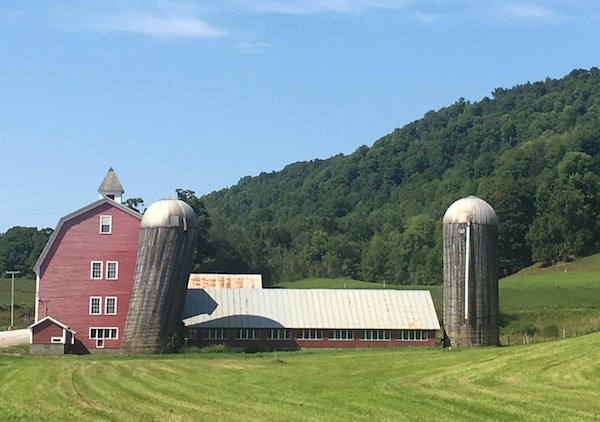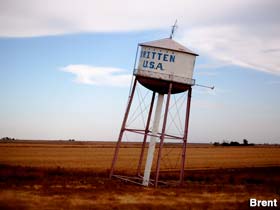I drive by this barn almost every day. I think the silo has been moving more lately. I've read about long term dam/bridge monitoring projects.
I'm thinking I might put a hub at my observation point and then set one vertically directly below the center cap at the top, and in front of the silo. Either that, or just take a back sight on the cupola.
Then, periodically return and see if it's moved. I think the center of mass still has quite a ways to go before it gets critical. Any thoughts?
Why?
This could be an interesting learning experience. Consider three or four different monitoring approaches and then do all of them to see how closely they all agree.
BTW, about fifty pounds of little blue pills buried in the center of the bottom of the silo might correct the deflection problem.
Can you identify an unambiguous, well-defined point near the top of the silo to use for measurements?
Having a reference point near the same vertical angle as the top will help a lot with minimizing the effects of misleveling the instrument. I'm not sure how stable the cupola is, but quite possibly good enough compared to the expected motion of the silo.
It is tempting to use a vertical line in a window and the edge of the silo cap, but your pointings there may depend a little on the lighting conditions.
If you use a point near the ground, doing D+R will be critical for compensating any misalignment in the instrument, but of course won't do anything for misleveling.
I don't think you have many windstorms left before it's gone. Are the owners intending to just let it go and not do anything to correct it?
Jim in AZ, post: 389829, member: 249 wrote: Why?
Knowledge is wonderful, but understanding is the key.:)
Bill93, post: 389835, member: 87 wrote:
I don't think you have many windstorms left before it's gone. Are the owners intending to just let it go and not do anything to correct it?
I think so. I don't believe it's used anymore.
Holy Cow, post: 389832, member: 50 wrote: This could be an interesting learning experience. Consider three or four different monitoring approaches and then do all of them to see how closely they all agree..
That's really a pretty interesting structural calculation with the "Chinese handcuff" style of construction. I'm sure the entire cylinder is torqueing as it leans. There was an old two story house adjacent to a highway down here that was slowly leaning and twisting. A local radio station had a raffle to see who could guess the date and time it eventually became "static".
Is it in use? If so, it has probably been getting loaded up at this time of year. That may be the cause of movement you have noticed.
They come down quick..if you smack them in the right spot.
[MEDIA=youtube]b2MaAgPW3sU[/MEDIA]
That's the problem with the lateral rings and vertical slabs of pre-cast concrete. The loading from silage is the greatest near the bottom and least near the top. That is why the rings are closer together near the bottom. The concrete slabs are being twisted as the silo leans and rotates. This puts tension loads where none were ever designed to occur. Concrete ain't worth a tinker's dam in tension but heck fer stout in compression.
Holy Cow, post: 389848, member: 50 wrote: That's the problem with the lateral rings and vertical slabs of pre-cast concrete. The loading from silage is the greatest near the bottom and least near the top. That is why the rings are closer together near the bottom. The concrete slabs are being twisted as the silo leans and rotates. This puts tension loads where none were ever designed to occur. Concrete ain't worth a tinker's dam in tension but heck fer stout in compression.
This one's wood. We'll find out if it's been recently used once it comes down.
Jim in AZ, post: 389829, member: 249 wrote: Why?

paden cash, post: 389847, member: 20 wrote: They come down quick..if you smack them in the right spot.
After first cutting a number of tension rings. I'm pretty sure the line "hold my beer and watch this" was uttered just before the recording started.
rfc, post: 389851, member: 8882 wrote: This one's wood. We'll find out if it's been recently used once it comes down.
Wood?! That's a horse of a different color...that calls for a kegger and a BIG bonfire.
paden cash, post: 389860, member: 20 wrote: Wood?! That's a horse of a different color...that calls for a kegger and a BIG bonfire.
I don't think I've ever seen a concrete silo in Vermont. That's a midwest thing. Makes sense though, for resistance to grain explosions.
rfc, post: 389875, member: 8882 wrote: I don't think I've ever seen a concrete silo in Vermont. That's a midwest thing. Makes sense though, for resistance to grain explosions.
I have seen some older timber silos. But this far south we have these little critters called termites that can reduce untreated timber to sawdust.
We used to monitor towers at a gas processing plant. Not only was it a hazardous area but the towers exceeded 100' in height. We set up on four control points outside of the area and made multiple sighting to the edges left and right at the top of the tower and at the bottom. All shots were processed with StarNet and the error ellipses approximated the diameters at the tops and bottoms. The towers were leaning significantly and continued to progress over the term which we monitored them.
KScott, post: 389909, member: 1455 wrote: We used to monitor towers at a gas processing plant. Not only was it a hazardous area but the towers exceeded 100' in height. We set up on four control points outside of the area and made multiple sighting to the edges left and right at the top of the tower and at the bottom. All shots were processed with StarNet and the error ellipses approximated the diameters at the tops and bottoms. The towers were leaning significantly and continued to progress over the term which we monitored them.
Once-upon-a-time I was a foolish party chief with a brand-spanking new Nikon TS, a top-mounted EDM and an HP41. I was bullet proof. In an attempt to display my and my crew's speed, accuracy and prowess I decided to attempt a large and complex boundary by occupying a spot on the catwalk of an abandoned water tower. The location was going to be determined by resection once I set up the gun...
A lot of people might not think that an empty water tower moves much...but it does. In a strong Oklahoma wind that thing was swaying back and forth about 2' at a height of 100'. I came down from the catwalk a humbled and somewhat wiser surveyor...
Tried setting up the tripod and gun on a not-too-steep-not-too-flat roof on a very old building. Not a good idea on old one-inch sheeting and shingles.





